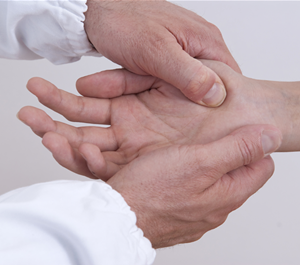Carpal Tunnel Syndrome and Pseudo-Carpal Tunnel Syndrome

Carpal tunnel syndrome is a compression of the median nerve as it passes through the carpal tunnel in the wrist.
Pseudo-carpal tunnel syndrome is much more common and is frequently misdiagnosed as carpal tunnel syndrome because of the similarity of symptoms.
Signs or Symptoms
| Nocturnal pain in the wrist or hand that interferes with sleep | |
| Hand weakness; tendency to drop objects | |
| Difficulty writing or difficulty opening jars. Loss of grip strength | |
| Atrophy of the muscles of the thumb | |
| Tingling, numbness, or pain in the palmar surface of the thumb, index, middle, and half of the index fingers | |
| Sharp, piercing pain shoots through the wrist and arm | |
| Paresthesia in the hands when walking or running |
Description

In true carpal tunnel syndrome, the median nerve is compressed, either by a decrease in the size of the canal, or by an increase in the size of the contents or both (swollen hands, inflamed flexor tendons, dislocated carpal bone, neoplasm, etc.).
It is critical that carpal tunnel syndrome be differentially diagnosed from pseudo-carpal tunnel syndrome and other types of peripheral nerve entrapments. Impediments can develop anywhere along the nerve, from the cervical spine down to the hand.
Repetitive movement is usually named as the primary cause of carpal tunnel syndrome, but the reality is that most of the time, there's a pre-existing metabolic imbalance that predisposes one to this condition. In fact, blood sugar issues and hyperinsulinism are usually at the roots of bilateral shoulder, arm, elbow, wrist, and hand problems.
Common Causes of Carpal and Pseudo-Carpal Tunnel Syndrome
| Systemic metabolic problems such as diabetes and hyperinsulism | |
| Vitamin (B-6) deficiency or other chemical imbalances | |
| Past trauma to the head, neck, shoulder, arms or hands | |
| Repetitive stress or over use of the hands in compromised mechanical positions | |
| Misalignment of carpal bones and/or radio-ulnar articulation | |
| Proliferation of the cartilage in the carpal tunnel | |
| Connective tissue adhesions on the nerve in the tunnel | |
| Inflammation in the tunnel | |
| Inflammation and swelling of the nerve in the tunnel | |
| Edema in hands and wrists | |
| Paresthesia in the hands when walking or running |
Chiropractic / Applied Kinesiology Approach to Carpal Tunnel Syndrome

Dr. Morrison employs standard orthopedic and neurological tests in conjunction with A.K. muscle testing, to differentiate whether symptoms are stemming from problems at the elbow and wrist, or coming down from higher nerve centers in the brain.
All three sides of the triad of health must be considered (chemical, emotional, and structural) when dealing with Carpal Tunnel Syndrome. As such, therapy is thorough, effective, and results are long lasting.
Back | Schedule an appointment
 SCHEDULE AN APPOINTMENT
SCHEDULE AN APPOINTMENT








